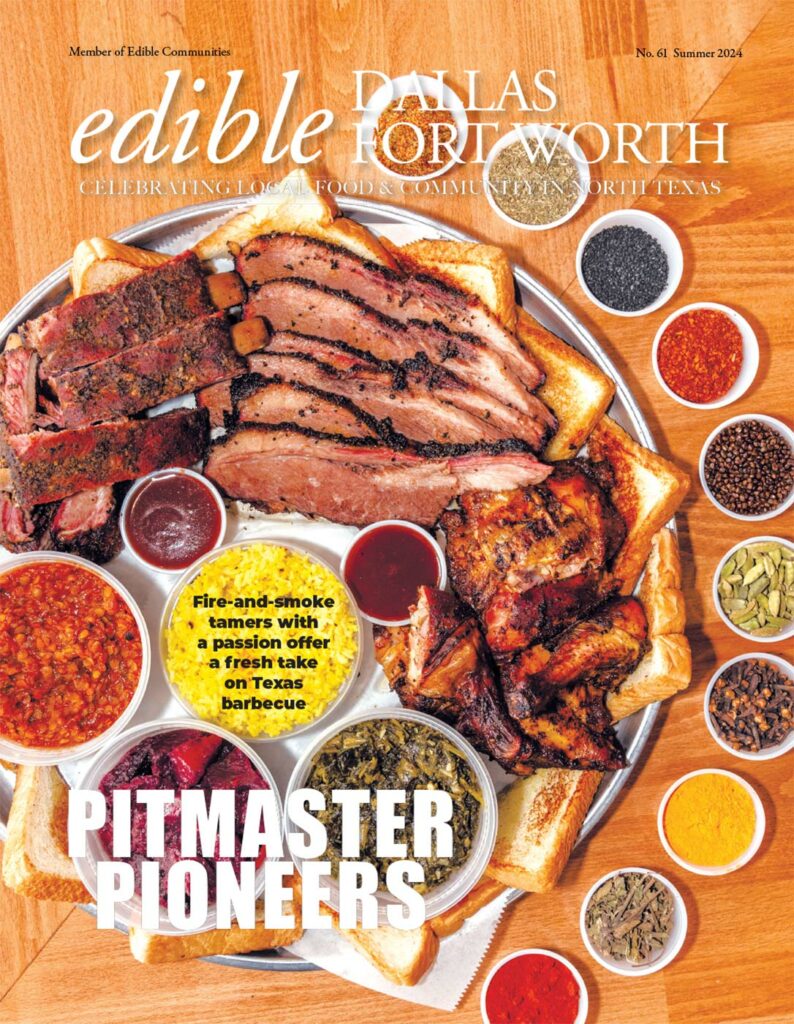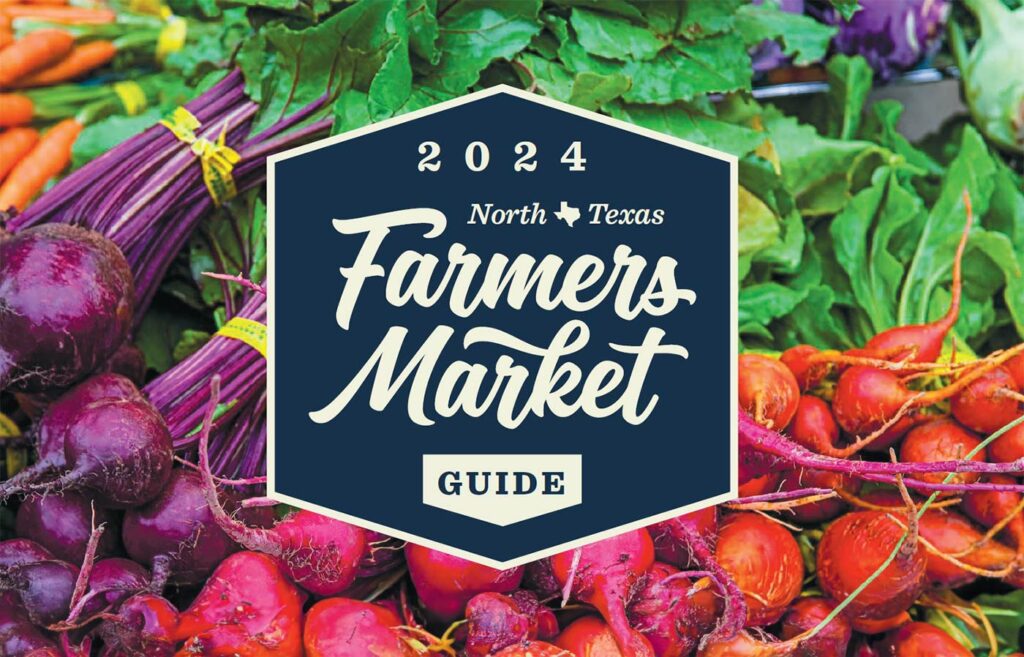Making Connections with CSAs and Co-ops

Screeeeee-Whack-BANG went the screen door at my grandparents’ house in East Texas. In walked a country farmer, big hat in hand, wearing painfully clean overalls, and carrying a cardboard box full of something special. Maybe it contained those perfect little cucumbers for lazy housewife pickles, a bushel of peaches, or even catalpa worms for bream fishing. My grandparents’ generation knew the people who we now call local producers. They knew their stories, their specialties, and their troubles.
These days, few of us know where our food comes from, when it was harvested, or whose hands shaped it. But now, everyday folks in Dallas and Fort Worth are hungering to get back to a little taste of the garden. This is the story of three people who help us rediscover those roots and link us with communities. They do it in different ways, with different philosophies, and with different results.
Looking Back
Many of us can recall the widespread demise of the small family farms in the 1980s. A trio of blockbuster films released in 1984 (Country, The River, Places in the Heart) conveyed the trauma in America’s heartland to pop culture, and a few guys named Willie, Neil, and John started an organization called Farm Aid (www. farmaid.org) to raise awareness and money for the small farmer. The costs of running a farm on a small scale had by far outstripped its income. Only 2% of the American population still lived on a farm.
In 1985, a movement called CSA short for Community Supported Agriculture began with the goal of creating an economically viable life for the small farmer. Co-founder Robin Van En found inspiration in the Japanese system of tekei (meaning food with the farmer’s face on it) wherein farmers agreed to grow produce for families that agreed in turn to provide them with financial support. Originally, CSAs started with a community that held farmland in a legal trust. The community then leased the property back on a long-term basis to the farmers who in turn grew food for the community. The initial efforts resulted in mixed success; however, descendents of the two seminal farms still operate today. You can read about them at www. templewiltoncommunityfarm.com and www.indianlinefarm.com.
Today, the term CSA cannot be defined simply because the meaning has splintered and changed over time. The Local Harvest website (www.localharvest.org) defines a CSA as follows “… a farmer offers a certain number of ‘shares’ to the public. Typically the share consists of a box of vegetables, but other farm products may be included.
Interested consumers purchase a share (aka a “membership” or a “subscription”) and in return receive a box (bag, basket) of seasonal produce each week throughout the farming season.” The website also includes a good list of tips and questions for those considering joining a CSA as well as resources for finding a CSA in your area.
Under the CSA system, the members get to know the farmer’s face. They share the risks and rewards of agriculture: maybe too much okra one year or too few tomatoes the next. Produce is expected to be fresher, tastier, more nutritious, and often organic. Farmers are paid in advance, so that they know how much to plant, and so they do not have to try to market goods during the busiest growing seasons of the year.
Two of our profiled entrepreneurs operate more conventional CSAs, Eden’s Organic Garden Center (www.safe-gardens.com) and Squeezepenny Sustainable Farm (www.squeezepenny.com). Your Health Source (www.yourhealthsource.org) is an organic food co-op with a different philosophy. Its mission is to supply members with local organic fruit and produce, while pulling bounty from farms around the country and abroad in order to meet the organic needs of its members.
Eden’s Organic Garden Center
Marie Tedei’s Eden’s Organic Garden Center and CSA in Balch Springs adheres closely to the original CSA concept. Her shareholders commit to pay an amount up front for their portion of the season’s produce. They pay in three installments and pick up their weekly shares at the farm, or at a remote drop for a small additional fee. Alternatively, members can work for their shares, or enter into a part work/part pay arrangement. Basically, members pay Marie’s salary and expenses for both running her farm and growing their food.
Marie and her farm are very much a work in progress. “I’m so green, I’m yellow!” she exclaims, noting that this is her second year as a farmer, after a long career as a horticulturist. That freshness and her blank slate of a 14-acre farm allow her to experiment, learn, and upgrade her operations daily.
For example, Marie has made friends with a retired engineer who, in a former life, designed renewable energy resources for oilfields. For less than $500, he designed a system to pump water from the farm’s pond up through a system of “lay flat” hoses and drip tape to water the fields and keep vegetables growing in spite of our hot Texas weather. It includes a windmill and two solar panels that drive energy into DC batteries, that then power the pump.
There are also many risks involved in Texas agriculture. A recent downpour washed away all of Marie’s recently planted seeds. When I met with her, she had just spent the morning on her hands and knees, replanting her crops. “I love growing for people I’m getting to know,” she says, and thinks of specific customer’s likes as she plants a potato, another’s dislikes as she cultivates a particular variety of tomato.
Marie refers to her customers as supporters, and talks about how they stuck with her during good times and bad her first year. A drought and early frost in the fall felled her crops, and her father’s illness and death in the New Year challenged her focus, but her supporters rallied with her. They visited her at the hospital, attended her father’s funeral, showed up again in the spring to work with her, enjoyed the fruits of her field, and enrolled in the CSA for another year. Her vision for the future includes an expanded direct sale farmers market on her property, along with a learning center offering classes in canning, cooking, and gardening that will “draw people back to the land and learning life skills.” Marie signs her emails with a quote from Henry David Thoreau: “If one advances confidently in the direction of his dreams and endeavors to live the life which he has imagined, he will meet with a success unexpected in common hours.” It seems to fit.
Squeezepenny Sustainable Farm
Penny Braley is starting small, but thinking big. A longtime member of a farming family and McKinney resident, she’s executing her plan for what she calls “sustainable development”. At a time in her life when many people kick back and enjoy the grandkids, Penny is starting a new business with the goal of making sure the next generation has resources to sustain them.
The cost of a share of Squeezepenny (the name is play on words, reflecting Penny’s frugal nature) is not tied directly to the farms’ revenues and expenses as in a classic CSA model. Instead, it is market-based, and aims to provide a good value to the customer. All vegetables and fruits are grown in an organic (though not necessarily USDA-certified) and sustainable fashion. Penny sets up various delivery locations in the McKinney and Frisco areas, based on her customers’ needs. When she can, she brings her mother, daughter, and granddaughter along to demonstrate the thread of continuity, of life passing from one generation to another. The CSA grew from 8 shareholders last summer to 66 in the fall.
Penny’s long-term vision of the CSA and sustainable development involves community and politics. She says it’s not just about raising good food and money. It is also about changing the direction of land use in Collin County, creating more sustainable small farms and reducing the number of half-completed and abandoned housing developments.
Penny would like to expand her own farming operation to include five 10-acre farms to grow hydroponic lettuce. She plans to apprentice employees at the farm so that in time they can purchase the farm themselves. She calls this idea a spillover, not a spin-off. By sticking with the basics of organic, sustainable farming, growing healthy food, and creating good jobs for people in the community, she can equip new farmers with skills, assets, and training that can be passed on to the next generation.
Your Health Source
Monica Brown started Your Health Source, an organic food cooperative, 8 ½ years ago when health issues plagued her family. From a community of friends, it has grown to include more than 1,000 members and about 50 drop locations, not only in the Dallas-Fort Worth area, but also in San Antonio, Austin, Oklahoma, and Colorado.The co-op differs from a CSA in that the focus is more on the food than the farmer. While Monica’s first choice would be to supply her co-op with only local produce, today there simply aren’t enough farmers in Texas growing organic produce to meet her needs, so she pulls her goods from producers around the country, and gets items like bananas and avocadoes from other countries.
To participate, customers pay a membership fee and an additional fee every other week for a laundry basket-sized box of organic produce.Each week, members arrive at a prearranged site to pick up the week’s filled box and drop off last week’s empty basket. Host families get a price break for receiving the bulk delivery the morning of the food drop, and for dividing the produce up into portions for each box.
On the day that I visited one of Monica’s pickup sites, she was there with her husband and her five (soon to be six) children. A couple with eleven children aged 1-19 hosted the meeting and almost 40 families visited that day, drawn together by the common thread of healthy food. Local producer Rusty Roth (www.rustysbeef.com) brought grassfed beef, sorbet, and ice cream to sell and conversations were vibrant. Members exchanged tips on growing kefir grains and home schooling techniques and they anticipated upcoming classes on weaving, grinding wheat, and stocking a healthy pantry. These people clearly felt positive about the difference in the lifestyle that they were creating for their families, and were doing a lot more than simply shopping.
And So
In spite of our efforts to industrialize the growing process, farming includes aspects of life and death, beyond our control. Americans are growing leery of the endless summer season of food for sale in our local grocery stores. Texans are joining others around the country and embarking on a trip back to the garden. According to USDA Farm Census data, the number of hobby farms has grown in recent years giving us more choices when it comes to our food. Local farmers markets are springing up, and even big chain grocery stores now tout their Locally Grown products. CSAs and food co-ops provide one more link to eating fresh and local food, as well as helping to create viable, sustainable communities. We can bloom where we’re planted, cultivate relationships with local farmers, and receive produce fresh off the vine delivered to our back screen door.
“We are stardust, we are golden, And we’ve got to get ourselves back to the garden.” Joni Mitchell
NANCY KRABILL is a native Texan and freelance writer, equally and possibly schizophrenically passionate about local food roots and Italian culture. In her other life, she organizes media trips to Tuscany and Le Marche with a focus on food and wine. Contact [email protected]











